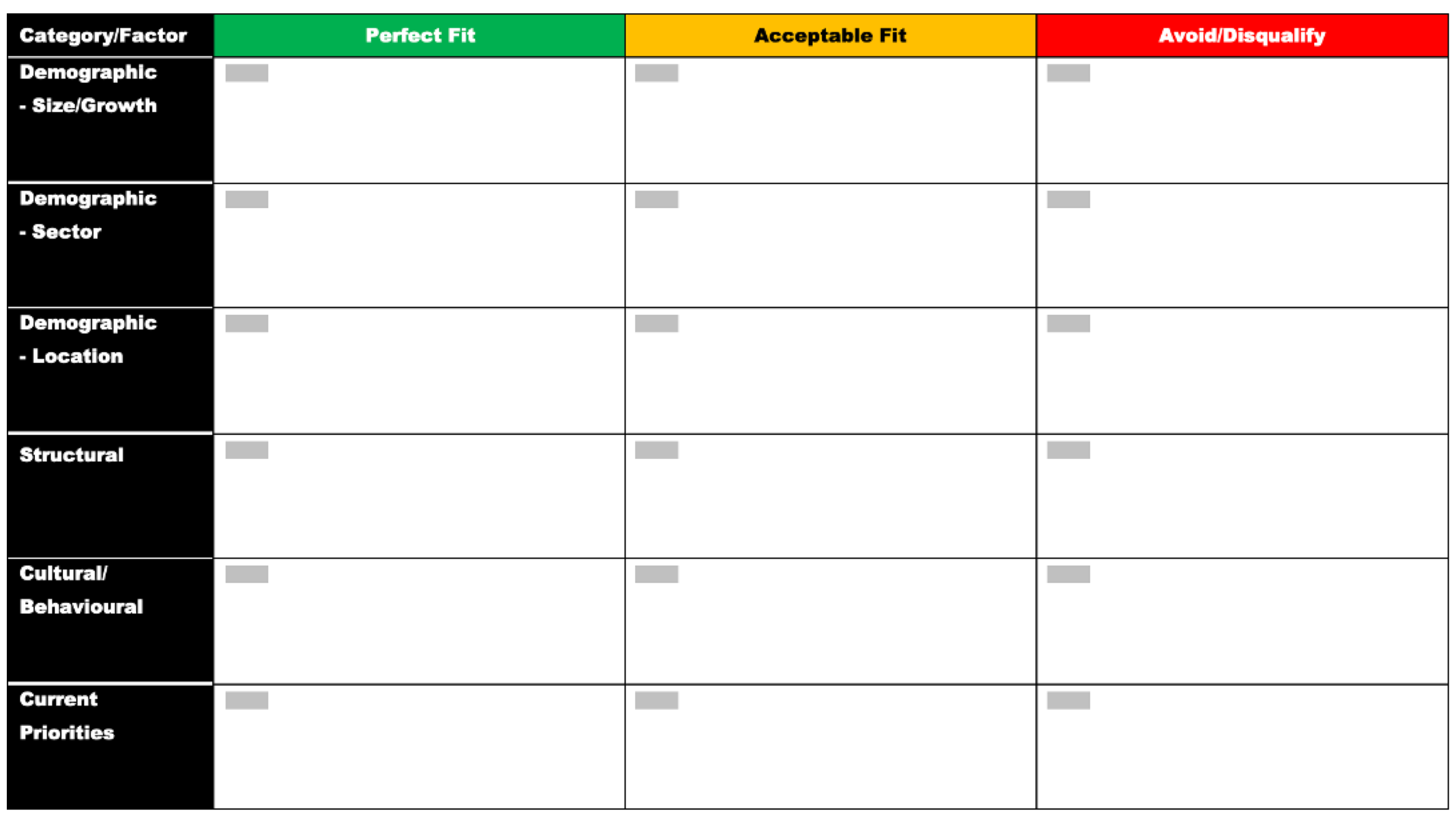No Fit, No Deal: Why ICP Fit Must be the First Thing You Qualify in Complex B2B Sales
June 27, 2025

By their very nature, high-value complex B2B sales typically involve multiple stakeholders, lengthy and frequently convoluted buying journeys and (often) serious competition. Winning usually requires smart thinking, effective execution, and a certain amount of luck. At the end of the day, and after a great deal of sales effort, the customer can still decide to do nothing - or to do something else.
Given the amount of resource that needs to be invested to win these deals (and the level of wasted effort that is associated with failure), it’s no wonder that many sales organisations have implemented a structured opportunity qualification framework - whether MEDDICC, SPICED or (for those still living in the Stone Age) BANT.
But while these opportunity-level qualification methodologies, if implemented consistently and effectively, can help to evaluate whether a specific opportunity is worth pursuing, they all ignore one crucial question: is this the sort of organisation we can do profitable business with?
Opportunity-level qualification is much less valuable if the prospect doesn’t align with your Ideal Customer Profile (ICP). ICP fit is the single most important determinant of whether a prospect is ever likely to buy, pay for, successfully implement, and continue to value your solution. If the organisational fit is fundamentally misaligned, even apparently attractive opportunities might not be worth pursuing.
ICP: More Than Just a Marketing Tool
Unfortunately, some organisations think of their ICP (if they think of it at all) in narrow demographic terms - such as industry verticals, employee count, or annual turnover. But these are merely starting points. They only serve to define the outer boundaries of their addressable market. They tell us very little about the likelihood that a specific organisation will choose to buy from us.
Gartner’s Hank Barnes has written extensively on the factors that really determine whether an organisation is likely to buy from a given vendor. He recommends going beyond the basic demographics and firmographics and thinking about the attitudes and practices of your ideal customers.
A truly effective ICP, then, is not just a profile of organisations who could potentially use your solution, but which ones are most likely to buy from you, to implement your solution successfully, and to generate sustained value from the relationship.
The Essential Elements of an Ideal Customer Profile:
Ideal Customer Profiles can be thought of as a nested series of progressively more useful predictive factors:

- Demographic Factors: Such as number of employees/potential users, vertical market, industry, function, location, turnover, and so on - these define the “outer boundaries” of your target market for a given offering
- Structural Factors: Such as organisational structure, current systems, market focus, go-to-market model, market position and so on - these have a significant influence on their likely buying behaviours
- Cultural/Behavioural Factors: These include appetite for innovation, willingness to buy best-of-breed, attitude to vendors, decision-making style, and so on - these are likely to have a significant influence on their preference for different vendors
- Current Priorities: These include other competing projects, and their initiatives and priorities related to the business issues we are targeting - these have a significant impact on the likelihood they will take action, and that they will choose to do so with us
For each of the above factors, it is helpful to define what a “perfect” fit and a “good-enough” fit looks like, but it is also very useful to define the characteristics of organisations that are never likely to become valuable customers - so that we can either avoid targeting them in the first place or politely disqualify them if they approach us.
Here’s an example of a one-page ICP framework that uses a “traffic light” (Green-Amber-Red) approach to highlighting factors that make for a perfect ICP fit, factors that make for an acceptable fit, and factors that should result in avoidance or disqualification.

ICP Fit Comes Before Opportunity Identification
The importance of ICP fit begins long before a deal enters the pipeline. It should guide who vendors choose to prospect to, how they choose to position themselves, and what they choose to prioritise.
Many marketing and sales teams fall into the trap of casting the net wide, engaging anyone who shows interest. But a reactive approach to prospecting often creates bloated pipelines full of deals that will never close - because the organisations behind them were never a good fit to begin with.
Instead, sales and marketing teams need to work together to intentionally target accounts that reflect strong ICP characteristics and appear to be in the “perfect fit” zone. The organisations and people targeted, issues raised, and language used should be designed to resonate with and attract organisations that are likely to have strong ICP alignment.
ICP Fit as the First Gate in Qualification
Every modern sales organisation has some form of deal qualification. But in many cases, the sales rep is already well into discovery before they ask the questions that frameworks like MEDDICC or SPICED require. At that point, time and resource have already been invested - making it harder to walk away from a bad fit.
That’s why ICP fit must be the first qualification filter - before the deeper questions of pain, process, authority or metrics are explored.
If the prospect fails the ICP test, the opportunity should never enter the forecast. Here’s why:
- Forecast reliability increases: When your pipeline is filled with ICP-aligned opportunities, win rates go up and sales leaders can plan more accurately
- Churn reduces: Customers who were a great ICP fit before the sale are far more likely to renew and expand
- Sales team productivity improves: Reps spend more time on the deals most likely to convert
How to Operationalise ICP Fit
- Make ICP Fit Visible in the CRM
Introduce fields that require reps to explicitly score the ICP alignment of a prospect. Include both firmographic and behavioural indicators - e.g., “Is this company similar to our top 20 customers?” or “Have they expressed the types of current priorities we solve best?” - Make Disqualification an Organisational Strength
Reps should be coached to value rational disqualification as much as qualification. The discipline to walk away from bad deals is a hallmark of top-performing salespeople and sales organisations - Implement an ICP Scoring System
Build a simple weighted scorecard that includes critical ICP characteristics. Use it to guide prospecting and validate opportunities before resources are committed - Align Sales and Marketing Around ICP
Ensure outbound campaigns, content, events and partnerships are tailored to attract and engage high-quality ICP-fit prospects - rather than generate a high volume of low-quality leads - Continuously Refine the ICP Definition
The best organisations revisit their ICP regularly, looking at which customers succeed fastest, renew consistently, or deliver the best margins. This makes the ICP definition sharper and more predictive over time
It’s About Fit, Not Force
In complex B2B sales, time is a non-renewable resource. Chasing poorly aligned opportunities is not just wasteful - it’s damaging. It ties up resources, skews forecasts, and burns out salespeople. Most importantly, it leads to failed implementations and unhappy customers.
Conversely, when sales teams focus on fit above all else, every part of the go-to-market motion improves. Pipeline quality goes up. Win rates go up. Forecasts get more accurate. Customer satisfaction increases.
Sales qualification frameworks like MEDDICC, BANT, and SPICED remain powerful tools - but only after the prospect has cleared the ICP filter. Because unless there is strong alignment on who your best customers really are, the rest is just process theatre.
At least, that's what I think. What about you?


Comments